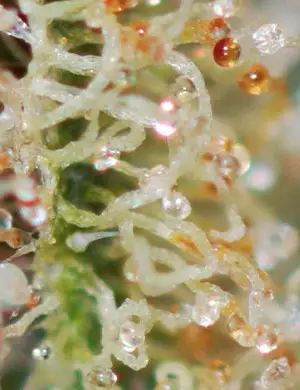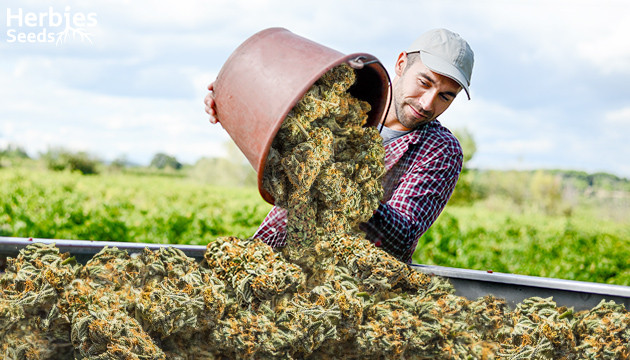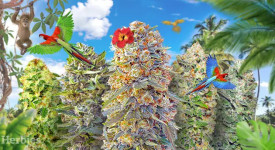
Cannabis Trichomes: Everything You Need To Know

The complex composition of a cannabis plant hides many fascinating details. Some of them are so tiny, you’d need a microscope to take a good look at them! One such detail we’re talking about is cannabis trichomes. If you’ve ever seen a marijuana bush up close, you’ve likely noticed them – a layer of tiny, shiny crystals that covers the buds and leaves like a blanket. Ever wondered what exactly they are? There’s definitely more here than meets the eye. Let’s find out!
What Are Cannabis Trichomes?

Derived from the Greek trícha, meaning ‘hair’, the word trichome can be defined as a miniscule outgrowth on surface plants – in our case, cannabis. Trichomes cover the majority of the plant’s outside, including the buds and leaves, where their concentration is the densest. When viewed with the naked eye, trichomes look like a shiny coating that gets more pronounced in the areas surrounding budding blooms. To view weed trichomes more closely, growers can use a macro-camera, microscope, or magnifying glass. They help see that trichomes aren’t a uniform coating, but separate opaque glands shaped like tiny mushrooms.
However, trichomes don’t only give cannabis flowers a crystalline sheen that turns them into delightfully frosty buds. They actually serve a very important function in regard to cannabis compounds.
Trichomes are single-handedly responsible for the production of the effects and flavors of your favorite strains. Each cannabis trichome is a microscopic factory that produces precious cannabinoids, terpenes, and flavonoids that contribute to the rich chemical composition of the cannabis plant. And it is, of course, trichomes that are full of that THC-rich resin used for extraction.
If you’re a fan of cannabis concentrates, you’ve got trichomes to thank. To produce concentrates like wax and shatter, trichomes are separated from the plant matter by applying gentle physical force, as in shaking, or with solvents like Everclear or butane. The result? Popular cannabis concentrates that are known for their powerfully potent effects.
What Are The Functions Of Trichomes?

Despite their small size, the functions of trichomes are vast. They play different roles depending on the plant species – for instance, in some plants, trichomes are responsible for keeping plants protected and healthy. Some carnivorous plants, like the Venus flytrap, even use trichomes to lure and catch their prey.
When it comes to cannabis trichomes, these glands serve a few protecting purposes.
- First, they deter various garden pests when female plants start developing buds. Cannabis flowers can become a tempting source of feed for aphids, caterpillars, and other pests. With their strong, pungent aroma, trichomes discourage insects and other predators from feasting on marijuana’s precious buds.
- Trichomes on weed also keep larger predators away from the plant. If you’ve ever grown outdoors, you know that deer, rabbits, squirrels, and chipmunks love to snack on budding cannabis. The sticky, resinous trichomes on buds can help deter these plant-loving animals from destroying your harvest.
- Mature trichomes protect weed plants from environmental elements. They shield marijuana from the sun’s strong UV rays, acting like a natural sunscreen. Moreover, when the wind blows at dangerously high velocities, trichomes can help protect cannabis plants from these otherwise damaging gusts. Trichomes are also known to regulate the plant’s temperature by deterring frost from reaching leaf cells, and can likewise help reduce evaporation when exposed to extreme heat.
Interestingly enough, seasoned growers have learned to use the protecting functions of trichomes to their benefit. Some, for example, claim to boost the production of cannabis trichomes, and therefore the cannabinoids and terpenes, by shocking the plant with high or low temperatures or decreased humidity.
Types Of Cannabis Trichomes

Among the various plants with trichomes, you’ll find quite a varied number. When it comes to marijuana trichomes specifically, however, there are three main types of these resinous glands.
Bulbous Trichomes - The Smallest Kind With No Stalk
When it comes to cannabis trichomes, bulbous trichomes are the tiniest kind. Despite covering most of the surface of the cannabis plant, bulbous trichomes are invisible to the naked eye. To put their size in perspective, think of this: the thickness of bulbous trichomes is approximately 15 micrometers at best, while a single human hair is 50 micrometers thick! Because of such small volume, bulbous trichomes carry the least amount of cannabinoids, terpenes, and flavonoids.
Capitate Sessile Trichomes - The Medium-Small Glands
Capitate sessile trichomes are a just bit larger than the bulbous type. They likewise cover the entire cannabis plant but contain higher levels of chemical compounds of marijuana.
Capitate sessile trichomes take on the “traditional” trichome mushroom-like shape, in that they have a small, single stalk and a noticeably bulbous head. They typically reach sizes of up to 25-100 micrometers and contain 8-16 cells each.
Capitate-Stalked Trichomes - The Biggest And Fullest Type
When growers discuss weed trichomes, they’re usually talking about capitate-stalked trichomes. First, this is where the magic happens – these trichomes are the largest and hence carry the biggest amount of cannabinoids and other compounds. Second, you can see these 50-500 micrometers big trichomes with the naked eye, and through your camera lens or a magnifying glass if you want to view the details.
Capitate-stalked trichomes also have that signature mushroom-like shape with a single stalk and a large bulbous head. This top part, by the way, is the place of the biggest concentration of cannabinoids, terpenes, and flavonoids in the entire cannabis plant.
When Do Trichomes Appear?

Cannabis plants start actively producing trichomes on leaves after the switch to the flowering stage. Once they begin to produce flowers, trichomes on the buds become apparent too. After the trichomes emerge, cells within the gland’s bulbous head begin to go through maturation – a process that will eventually turn them into cannabinoids, terpenes, and flavonoids. That’s why, during the flowering stage, growers are advised to invest in carbon filters and properly aerate the grow room. The more flavorful the terpenes produced, the stronger the smell of the plant.
Just how quickly are cannabis trichomes produced? As with many other cannabis characteristics, it all depends on the strain and varies from plant to plant. Generally, the lifecycle of a marijuana trichome corresponds to the lifecycle of the pot plant itself, and trichomes are therefore a huge indication of when marijuana is ready to harvest.
Color Of trichomes

Harvesting cannabis plants at the right time is extremely important when it comes to receiving the effects you’re hoping for. The color of the trichomes themselves is what largely determines when a cannabis plant is ready to be cut and what effects you can expect from the harvested buds.
But what does the color of trichomes tell you?
Clear Trichomes
When they first emerge, cannabis trichome bulbs and stalks tend to be translucent and crystal-clear like dew. At this point, the concentration of the chemical compounds we’re looking for is at its lowest. If your trichomes are at this stage, it’s still too early to harvest.
Cloudy (Milky) Trichomes
As they mature, trichomes change from clear to cloudy and milky. When you notice this change of color of trichomes, it’s a good indicator of the harvest time getting closer. At this point of cannabis development, milky trichomes already contain a good amount of cannabinoids and terpenes, and the plant becomes very fragrant.
Amber Trichomes
At the end of their lifecycle, trichomes change their color one last time to a rich amber hue. These gold-like trichomes contain the largest amount of THC and other compounds.
When To Harvest Marijuana According To Trichome Ripeness
By now, you know that amber trichomes contain the biggest cannabinoid content, but does that mean you need to harvest when all the trichomes have turned amber? It’s not that simple. Let’s dig a little deeper to learn exactly when to harvest according to the trichome color.
How To Check Trichomes
First of all, how do you check the color of trichomes? A great way to check if the trichomes are ready for harvest is by using a trichome microscope, a magnifying glass, or simply zooming in on them with your mobile phone. Keep your eye on the trichomes from early in the flowering stage to watch them mature and change color.
Clear Vs. Cloudy Trichomes
If your trichomes are still clear, you can interpret this as a clear “no” for harvesting. It’s way too early because the cannabinoid content in clear trichomes is at its lowest.
When the majority of trichomes have turned milky, this indicates they’re almost ready to transition to their final golden hue. The milky color also shows that inside the trichomes, their cells have partly turned into cannabinoids, terpenes, flavonoids, and other useful compounds. After all the trichomes have turned milky, it typically takes about two weeks more for them to turn amber.
Milky Vs. Amber Trichomes


The period during which trichomes transition from cloudy to amber is when the THC within becomes fully ripe and harvest time is at its peak. You should know that the effects of harvested buds largely depend on the trichome color.
Typically, cannabis plants that are harvested when most trichomes are still cloudy in color result in more pronounced cerebral, psychotropic effects. However, the THC levels will be not at their peak.
Harvesting buds when trichomes are a combination of both cloudy and amber results in a balanced combination of head and body high. However, the final effect is also largely influenced by the strain and the plant’s genetics.
If you wait until around 70% of trichomes have turned amber, you’ll get the highest THC concentration and more pronounced body-buzz along with the high effects. IMPORTANT: Don’t let the number of amber trichomes go over 80% – at this point, the buds overripen and start to degrade in quality. If you aren’t sure whether you can catch the right moment, it’s better to harvest a little earlier than a little later.
The best way to test your preference is to have the same plant harvested at different stages of the trichomes’ ripeness. For example, harvest a portion of buds when a quarter of trichomes have turned amber. Then continue harvesting when the ratio is close to 50/50. After that, harvest the rest when only a quarter of all trichomes on the buds remains cloudy. Dry and cure them separately and compare the effects to learn what your preference is.
FAQ
What weed has the most trichomes?
Some strains were genetically bred to produce larger amounts of trichomes for more potent and flavorful results. If you’re looking for trichome-laden strains that are great for smoking and extracting trichomes, you might want to check out White Widow, famous for her frosty, trichome-covered look, or OG Kush with its extra-thick trichome structure.
Do male weed plants have trichomes?
Yes, male weed plants also produce trichomes as a defensive mechanism. However, their amount is lower and the concentration of THC in them doesn’t exceed 3%.
How can I get more trichomes on buds?
To ensure your plant produces as many trichomes as possible, there are several tips you can use:
- Make sure you give the plant enough light throughout the grow, as UV light is crucial for trichome production.
- Use cannabis genetics known for increased trichome production.
- During the last 2-3 weeks before harvest, drop the humidity to 30% while keeping the temperature under 26C – this is the only proven stress method of boosting trichome growth.
Does rain wash away trichomes?
While heavy rain can break off some of the trichomes from your buds, this amount is usually insignificant.
How can I see trichomes without a magnifying glass?
The easiest method you can use to see the trichomes without a magnifying glass is by using your phone’s camera. Make sure there’s enough light in the room, point the camera at the bud, zoom in until you see the trichomes, and snap a picture.
How fast do trichomes change color?
This variable largely depends on the strain. Some transitions from one color to another can take around 5 days, while others take up to 2 weeks. Make sure to check your trichomes every day.
Why does my weed have no trichomes?
Some strains take longer to get powdered up – just give it some time. However, there can be problems with trichome production if you use seeds with poor genetics. That’s why you always need to buy seeds from trusted vendors. If the situation doesn’t improve, try implementing the tips from question 3.
Herbies Head Shop expressly refuses to support the use, production, or supply of illegal substances. For more details read our Legal Disclaimer.














Thank you for leaving a comment for us!
Your feedback will be posted shortly after our moderator checks it.
Please note that we don’t publish reviews that: